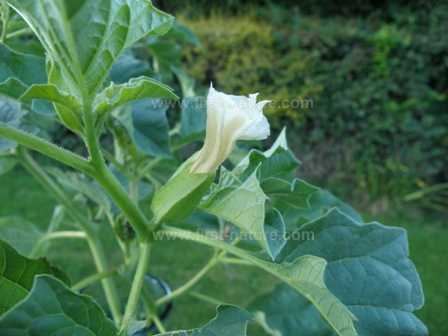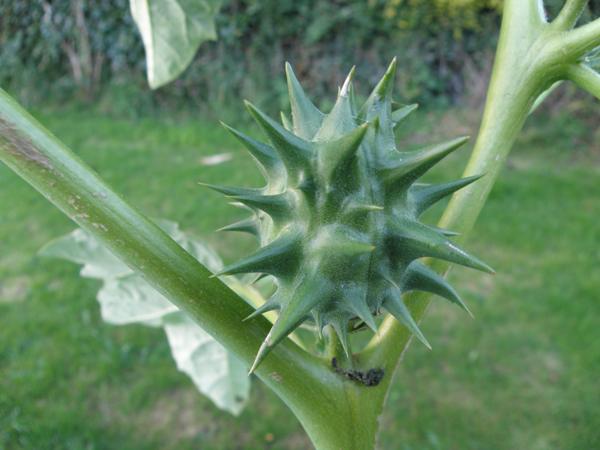Datura stramonium - Thorn-apple
Phylum: Magnoliophyta - Class: Liliopsida - Order: Solanales - Family: Solanaceae

The trumpet-shaped flowers of Thorn-apple are usually white, but can sometimes be tinged with purple.
The whole plant of Thorn-apple is extremely poisonous. It grows in the UK and throughout Europe but is hard to find because its appearance is dependent on the weather: it is more likely to appear during or at the end of warm summers. This annual plant grows on disturbed ground, including farmland, and also on waste ground and belongs to the same family that includes other generally poisonous plants such as Apple of Sodom - Solanum linnaeanum and Mandrake - Mandragora autumnalis.
The plant can grow to a size of 1.5 metres and has large lobed and jagged-looking leaves. The flowers are white and sometimes tinged with purple, and the fruits are dark green, egg-shaped and have sharp spines.

The spiny fruits of Thorn-apple
There are many myths and stories about Thorn-apple being used in potions made by witches and wizards, but it is true that the drug stramonium, which is produced from the plant, was used as a treatment for asthma up until the time of the Second World War. During that time the plant was actively cultivated for the purposes of supplying the pharmaceutical trade; and, despite efforts to completely eradicate Thorn-apple in more recent times, it continues to reappear in old sites during warm summers because the seeds are able to lie dormant in the soil for considerable numbers of years.
The specimens photographed on this page were found (after many years of looking for the plant) on the edge of a maize crop in a field in West Wales. The most likely cause of it appearing in such a place is the use of fertiliser sourced from South America having been applied to the soil, although not necessarily recently. Thorn-apple has become naturalised in many parts of Europe.
Sue Parker's latest ebook is a revised and enlarged second edition of the acclaimed Wildflowers in the Algarve - an introductory guide. Full details here...
Buy it for just £3.95 on Amazon...
Please Help Us: If you have found this information interesting and useful, please consider helping to keep First Nature online by making a small donation towards the web hosting and internet costs.
Any donations over and above the essential running costs will help support the conservation work of Plantlife, the Rivers Trust and charitable botanic gardens - as do author royalties and publisher proceeds from books by Pat and Sue.



